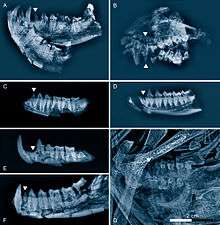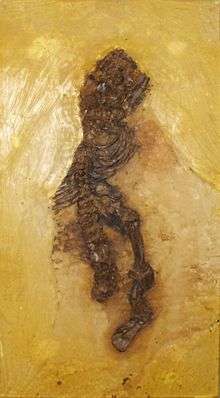Europolemur
Europolemur is a genus of adapiformes primates that lived in Europe during the middle Eocene.[1]
| Europolemur Temporal range: Middle Eocene | |
|---|---|
 | |
| Radiographic comparison of middle Eocene primates from Geiseltal, Germany. A to D are fossils of Europolemur klatti | |
| Scientific classification | |
| Kingdom: | Animalia |
| Phylum: | Chordata |
| Class: | Mammalia |
| Order: | Primates |
| Suborder: | Strepsirrhini |
| Family: | †Adapidae |
| Subfamily: | †Caenopithecinae |
| Genus: | †Europolemur Weigelt, 1933 |
| Type species | |
| Europolemur klatti Weigelt, 1933 | |
| Species | |
| |
Morphology

Europolemur klatti is part of a group of long-digited fossils, and most likely approximates early euprimate hand proportions. E. klatti has a grasping hallux and there is evidence that supports that E. klatti may have had nails instead of claws.[2] This insinuates that stabilizing the tips of the digits and hand must have in some way been an important function for them and their lifestyle in their habitat. Relative to the forearm, the hand of E. klatti was large which may be related to vertical climbing or posture. The shape of the calcaneus resembles that found in Smilodectes and Notharctus and E. klatti had an average body mass of 1.7 kilograms.[3]
Dentition
In 1995, two isolated upper molars belonging to E. klatti were found in an old lake deposit during excavations done by the "Naturhistorisches Museum Mainz/Landessammlung fur Naturkunde Rheinland-Pfalz".[4] The museum determined that the molars (as well as a mandible with nearly complete dentition belonging to another cercamoiines, Periconodon) were representative of the first primates from the Middle Eocene Eckfeld maar in Southwest Eifel, Germany. E. klatti has a dental formula of 2.1.3.32.1.3.3[2][5] (permanent dentition) and a deciduous dentition of 2.1.4.32.1.4.3.[2] One of the most distinguishing characteristics of the genus Europolemur is the lack of a metaconule. The dental anatomy of their genus is described in more detail by Franzen as consisting of "upper canines big and pointed; upper molars without postflexus; postprotocrista prominent; no metaconulus; M3 smaller and shorter than M2; P4 much shorter than broad, with a weak parastyle; P4 with a small and unicuspid talonid and a metaconid present to absent; protocristid of M nearly transversely oriented. Protoconid of P3 little higher than that of P4." [6]
References
- Gebo 2002, pp. 28–29.
- Martin, R.D. (1990). Primate Origins and Evolution: A Phylogenetic Reconstruction. Princeton University Press. ISBN 978-0-691-08565-4.
- Fleagle, J. G. (1998). Primate Adaptation and Evolution (2 ed.). Academic Press. ISBN 978-0-12-260341-9.
- "First fossil primates from Eckfeld Maar, Middle Eocene (Eifel, Germany)". Eclogae Geologicae Helvetiae. Birkhäuser Basel. 97 (2): 213–220. August 2004. doi:10.1007/s00015-004-1115-8.
- Franzen, J.L. (1987). "Ein neuer Primate aus dem Mitteleozan der Grube Messel (Deutschland, S-Hessen)". Courier Forschungsinstitut Senckenberg. 91: 151–187.
- Franzen, J.L. (2004). "First Fossil Primates from Eckfeld Maar, Middle Eocene (Eifel, Germany)". Eclogae Geologicae Helvetiae. 97 (2): 213–220. doi:10.1007/s00015-004-1115-8.
Literature cited
- Gebo, D.L. (2002). "Adapiformes: Phylogeny and adaptation". In Hartwig, W.C. (ed.). The Primate Fossil Record. Cambridge University Press. ISBN 978-0-521-08141-2. OCLC 47254191.CS1 maint: ref=harv (link)
- Covert, H. 1990. Phylogenetic Relationships among the Notharctinae of North America. American Journal of Physical Anthropology. Vol. 81, Issue 3, 381-398.
- Godinot, M. 1966. Functional Approaches of Paleogene Primate Hands. Geobios. Vol. 24, Issue SUPPLE. 1, 161-173.
- Godinot, M. 1992. Early Euprimitive Hands in Evolutionary Perspective. Journal of Human Evolution. Vol. 22, Issue 4-5, 267-283.
- Wilson, J.A. 1976. New Adapid Primate of European Affinities from Texas. Folia Primatologica. Vol. 25, Issue 4, 294-312.